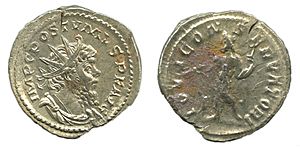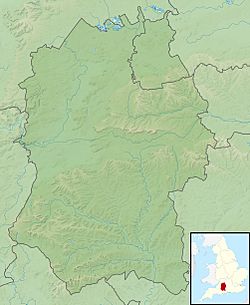Cunetio facts for kids
|
Cunetio
|
|

Cunetio within the River Kennet valley
|
|
| Location | Situated on a Roman road between Durocornovium and Venta Belgarum |
|---|---|
| Region | Britannia |
| Coordinates | 51°25′25.10″N 1°41′26.14″W / 51.4236389°N 1.6905944°W |
| Altitude | 130 m (427 ft) |
| Type | Walled Settlement |
| Part of | Britannia Superior |
| Length | 265 m (869 ft) |
| Width | 213 m (699 ft) |
| Area | 30 hectares (74 acres) |
| History | |
| Founded | 2nd century CE |
| Abandoned | Late 5th century CE |
| Periods | Roman Britain |
| Cultures | Romano-British |
| Site notes | |
| Discovered | 1940s |
| Excavation dates | 1960 - 2000s |
| Archaeologists | Wessex Archaeology Time Team |
| Condition | no extant remains |
| Management | Scheduled monument |
| Public access | no |
Cunetio was a large, walled town from the Roman times. It was located in the River Kennet valley in what is now Wiltshire, England. Near the village of Mildenhall, people lived there from the 2nd century CE until the early 5th century. After the Romans left Britain, the town was completely abandoned.
This ancient town remained hidden for a long time. It was only discovered in the 1940s using special aerial photos. Digging by archaeologists has shown that Cunetio was a big town with strong stone walls. Many interesting items have been found there, including kitchen tools, personal belongings, and two large collections of Roman coins.
Contents
Discovering Cunetio's Past

People knew about the Cunetio area since the 1800s, but they didn't know how big or important it was. Local history fans did some small digs back then. The true size of Cunetio was finally seen in 1940. This happened when aerial photos showed "crop marks" – patterns in fields that reveal hidden structures underground.
Since the 1950s, archaeologists have been digging at the site. They also keep taking aerial photos to map the town even better. In the 1960s, a small collection of coins was found. Then, in 1978, the much larger Cunetio Hoard was discovered. This amazing find included over 55,000 Roman coins!
In 2009, the TV show Time Team visited Cunetio. They dug and used special equipment to scan the ground. They found even more coins and other cool objects, helping us learn more about this ancient town.
Life and Layout of the Town
Cunetio started as a small settlement around a mansio. A mansio was like a guesthouse or inn for travelers on Roman roads. It was built near where two smaller Roman roads crossed. As the town grew, it developed a planned layout. The eastern part of Cunetio had a neat grid of streets and buildings made of stone. However, the western part had less organized structures.
Town Defenses: Walls and Towers
At first, Cunetio was protected by earthworks and a ditch. But in the 4th century CE, these were replaced by huge stone walls. These walls were about 4 m (13 ft) thick! The town also got a large main gate on its western side and 17 semi-octagonal towers built into the walls.
The new stone walls were built inside the old defenses on the east side. But on the south and west, they were built outside. The stone towers were placed about 36.7 m (120 ft) apart. Digs at the west gate show it had two towers on either side. It might have even had iron gates, like a portcullis, because grooves were found in the tower foundations.
It's a bit of a mystery why Cunetio needed such strong defenses. Most Roman military building projects at that time were focused on coastal forts, like the Saxon Shore forts. One idea is that the town was being turned into a military base to strengthen Roman control in the area. Another idea is that a powerful local leader was behind the improvements. This leader might have been trying to gain more power as Roman rule started to weaken. So, the strong walls could mean either the Roman Empire was trying to regain control, or its power was starting to break down.
Cunetio's Decline
In the 3rd century, Cunetio was a busy and successful town. By the early 4th century, it was surrounded by many large Roman villas (country houses). It's also thought that the town became a center for collecting taxes, managing the area, and military activities later in the 4th century. This was around the same time the strong defensive stone wall was added.
However, when the Romans officially left Britain around 410 CE, Cunetio quickly lost its importance. Eventually, the town was completely abandoned.


